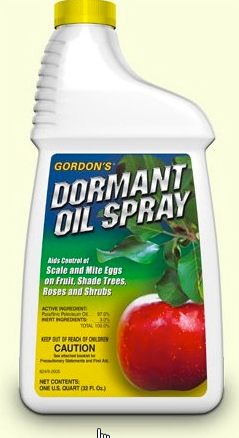Click below to listen to my 2 min. Garden Bite radio show: Dormant oils
What are dormant oils and when would you apply them? That is my mission today as a listener made the suggestion! I did some research on this topic as it’s not been on my radar.

A true dormant oil originally referred to heavier weight, less well-refined oils that were unsafe to use on plants after they broke dormancy (started to bud out in Spring) because they would burn and kill plant foliage.
Dormant oil is an oil based product, typically petroleum but can also be vegetable oil based, especially designed for use on fruit trees. These oils are effective in controlling certain scales and mites that overwinter as nymphs or adults.

What is a dormant oil? [Gardening Know How]
Horticultural oils [University of Connecticut]
Bio-rational pesticides [from University of Mass] – scroll down to Horticultural Oils
What is the difference between horticultural oil and dormant oil? [Weekend Gardener]
Surfactants are mixed in to enable it to be mixed with water. Once the oil solution is sprayed on all the branches of a tree or bush, it penetrates into the surface of the insect’s hard outer shell, and suffocates it. Dormant oil applications must be made when temperatures stay above freezing for 24 hours.
Dormant oil application [pouls.com]
Dormant oil [In Harmony – sustainable landscapes]
According to my research, Late Winter and Early Spring are the best times to use. Apples, crabapples, plums, quince and pears all benefit from dormant oil, as do gooseberry and currant bushes. So do many other ornamentals, trees and shrubs.

NOTE: For those of us in zones 2 to 5, we may be experiencing temperatures already too cold to apply the product… you may have to wait until late winter (let’s hope that’s March!)
